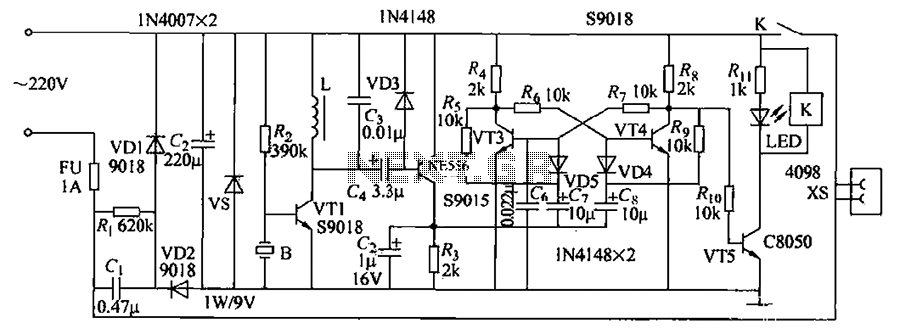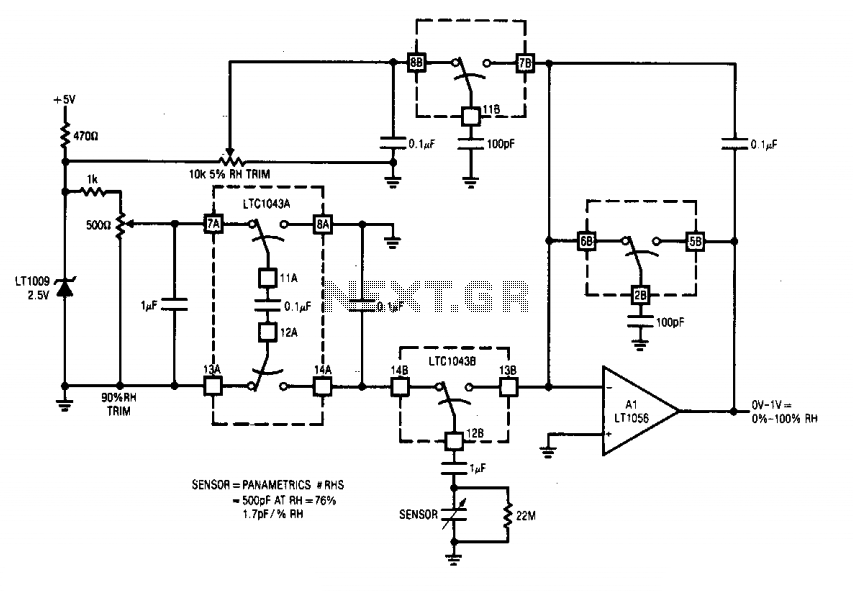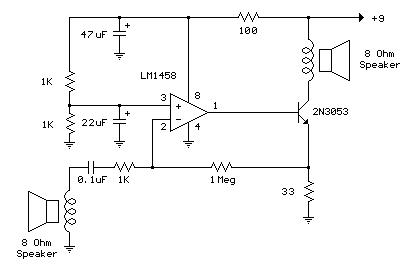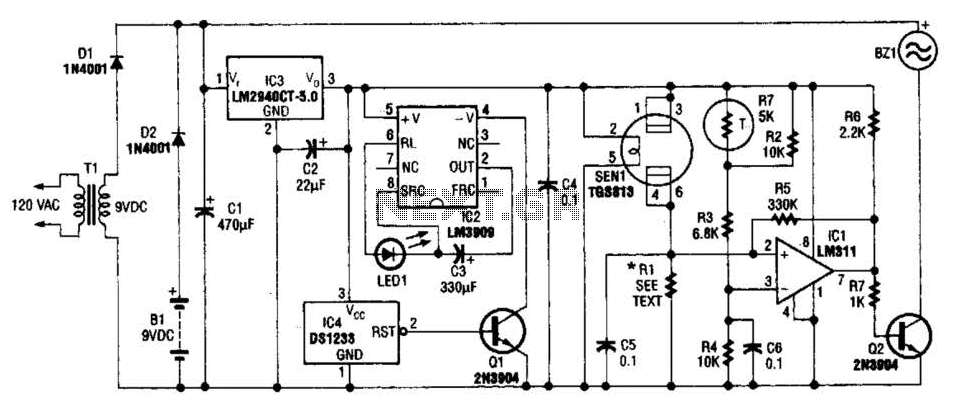
Mains Remote-Alert circuit

Pressing the pushbutton on the transmitter activates a sound and/or light alert in the receiver. This system operates without wiring or radio frequencies; instead, the transmitted signal is conveyed through the mains supply line. It is suitable for use in various locations within a home, from the attic to the cellar, by simply plugging the transmitter and receiver into wall mains sockets. The transmission range is optimal when both units are connected to the mains supply within the same light-meter control.
The described system utilizes a power line communication (PLC) technology, which allows for the transmission of signals over existing electrical wiring. This method eliminates the need for additional wiring or complex installations, making it an efficient solution for alert systems in residential settings.
The transmitter is equipped with a pushbutton switch that, when pressed, generates a signal. This signal is then modulated and superimposed onto the mains voltage, allowing it to travel through the electrical infrastructure of the building. The receiver, connected to the same mains supply, detects this modulated signal and responds by activating an alert mechanism, which can be either an auditory sound or a visual light indicator.
To ensure effective communication between the transmitter and receiver, both devices must be powered from the same electrical circuit. This requirement is crucial, as the signal relies on the integrity of the mains supply line for transmission. The performance of the system is influenced by factors such as the quality of the electrical connections, the presence of interference from other devices, and the overall layout of the electrical wiring within the building.
Installation is straightforward; users simply need to plug the transmitter and receiver into available wall sockets. This plug-and-play feature enhances the system's usability, allowing for quick deployment in various environments. The range of the system can vary based on the electrical setup, but it generally provides reliable operation throughout a typical residential structure.
In summary, this alert system offers a convenient and effective solution for notifying individuals of events or conditions within a home, leveraging existing electrical infrastructure for seamless communication.Pressing the pushbutton of the transmitter, a sound and/or light alert is activated in the receiver. The system uses no wiring or radio frequencies: the transmitted signal is conveyed into the mains supply line. It can be used at home, in any room from attic to cellar, simply plugging transmitter and receiver in the wall mains sockets.
Transmission range can be very good, provided both units are connected to the mains supply within the control of the same light-meter.. 🔗 External reference
The described system utilizes a power line communication (PLC) technology, which allows for the transmission of signals over existing electrical wiring. This method eliminates the need for additional wiring or complex installations, making it an efficient solution for alert systems in residential settings.
The transmitter is equipped with a pushbutton switch that, when pressed, generates a signal. This signal is then modulated and superimposed onto the mains voltage, allowing it to travel through the electrical infrastructure of the building. The receiver, connected to the same mains supply, detects this modulated signal and responds by activating an alert mechanism, which can be either an auditory sound or a visual light indicator.
To ensure effective communication between the transmitter and receiver, both devices must be powered from the same electrical circuit. This requirement is crucial, as the signal relies on the integrity of the mains supply line for transmission. The performance of the system is influenced by factors such as the quality of the electrical connections, the presence of interference from other devices, and the overall layout of the electrical wiring within the building.
Installation is straightforward; users simply need to plug the transmitter and receiver into available wall sockets. This plug-and-play feature enhances the system's usability, allowing for quick deployment in various environments. The range of the system can vary based on the electrical setup, but it generally provides reliable operation throughout a typical residential structure.
In summary, this alert system offers a convenient and effective solution for notifying individuals of events or conditions within a home, leveraging existing electrical infrastructure for seamless communication.Pressing the pushbutton of the transmitter, a sound and/or light alert is activated in the receiver. The system uses no wiring or radio frequencies: the transmitted signal is conveyed into the mains supply line. It can be used at home, in any room from attic to cellar, simply plugging transmitter and receiver in the wall mains sockets.
Transmission range can be very good, provided both units are connected to the mains supply within the control of the same light-meter.. 🔗 External reference
Warning: include(partials/cookie-banner.php): Failed to open stream: Permission denied in /var/www/html/nextgr/view-circuit.php on line 713
Warning: include(): Failed opening 'partials/cookie-banner.php' for inclusion (include_path='.:/usr/share/php') in /var/www/html/nextgr/view-circuit.php on line 713





